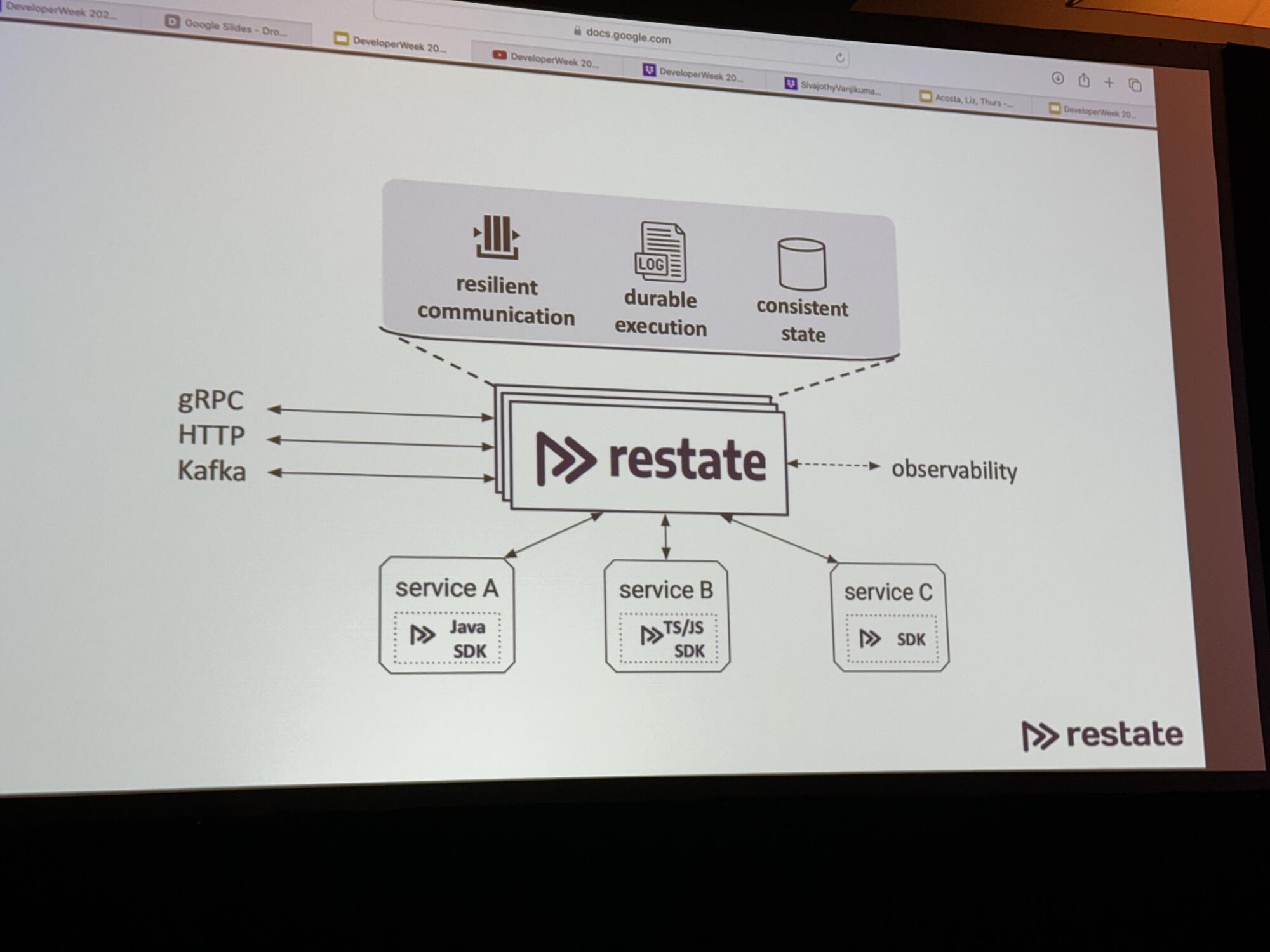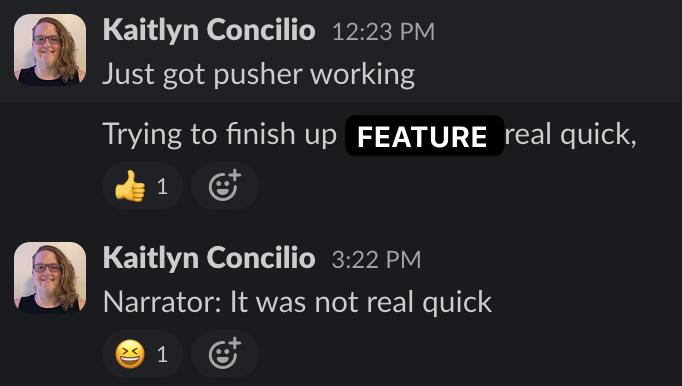The Game is a mind game in which the objective is to avoid thinking about The Game itself. Thinking about The Game constitutes a loss, which must be announced each time it occurs.
The programming version of The Game has the same rules, but you lose if you think about David Heinemeier Hansson (aka DHH).
And no, I'm not linking to why I lost today.
Broke a four-month winning streak, dangit.
If you rush and don’t consider how it is deployed, and how it helps your engineers grow, you risk degrading your engineering talent over time
—Angus Allan, senior product manager at xDesign
I don't disagree that overreliance on AI could stymie overall growth of devs, but we've had a form of this problem for years.
I met plenty of devs pre-AI who didn't understand anything other than how to do the basics in the JS framework of the week.
It's ultimately up to the individual dev to decide how deep they want their skills to go.
Your frontend is not your backend: Using data transfer objects to keep your code focused
Today I want to talk about data transfer objects, a software pattern you can use to keep your code better structured and metaphorically coherent. It’s a tool that can help you stay in the logical flow of your application, making it easier to puzzle through and communicate about the code you’re writing, both to yourself and others.
The DTO is one of my go-to patterns, and I regularly implement it for both internal and external use.
I’m also aware most people already know what pure data objects are. I’m not pretending we’re inventing the wheel here - the value comes in how they’re applied, systematically.
🎵 I got a DTOooooo
“[Random AI] defines ...” has already started to replace “Webster’s defines ...” as the worst lede for stories and presentations.
I let the AI interview in the playbill slide because the play was about AI, but otherwise, no bueno.
The way to guarantee durability and failure recovery in serverless orchestration and coordination is … a server and database in the middle of your microservices.
I’m sure it’s a great product, but come on.
I have previously mentioned that I love NextDNS, but they do not make certain fundamental things, like managing your block and allow lists, very easy. Quite often I'll hit a URL that's blocked that I'd like to see - rather than use their app, I have to load their (completely desktop-oriented) website, navigate to the right tab, then add the URL in.
That's annoying.
Without writing an iOS app all of its own (which sounds like a lot of work), I wanted an easy to way to push URLs to the block or deny list. So I wrote an iOS Shortcut that works with a PHP script to send the appropriate messages.
You can find the shortcut here.
The PHP script can found at this Gist. You'll need to set the token, API key (API key can be found at the bottom of your NextDNS profile) and profile ID variables in the script. The token is what you'll use to secure your requests from your phone to the server.
I thought about offering a generic PHP server that required you to set everything in Shortcuts, but that's inherently insecure for everyone using it, so I decided against it. I think it would be possible to do this all in Shortcuts, but Shortcuts drives me nuts for anything remotely complex, and this does what I need it to.
It really is annoying how hard it is to manage a basic function. NextDNS also doesn't seem to have set their CORS headers properly for OPTIONS requests, which are required for browser-based interactions because of how they dictated the API token has to be sent.
At least I finished it, eventually!
Implementing a share extension with SwiftUI
As part of my plan to spend more time bikeshedding building out my web presence than actually creating content, I wanted to build an iOS app that allowed me to share short snippets of text or photos to my blog. I've also always wanted to understand Swift generally and building an iOS app specifically, so it seemed like a nice little rabbit hole.
Be wary of chasing rabbits down their holesI later expanded the app's remit to include cross-posting to BlueSky and Mastodon, which is a double-bonus because BlueSky STILL doesn't support sharing an image from another application (possibly because they couldn't find the Medium post???)
I've recently been beefing up my homelab game, and I was having issues getting a Gotify secure websocket to connect. I love the Caddy webserver for both prod and local installs because of how easy it easy to configure.
For local installs, it defaults to running its own CA and issuing a certificate. Now, if you're only running one instance of Caddy on the same machine you're accessing, getting the certs to work in browsers is easy as running caddy trust.
But in a proper homelab scenario, you're running multiple machines (and, often, virtualized machines within those boxes), and the prospect of grabbing the root cert for each just seemed like a lot of work. At first, I tried to set up a CA with Smallstep, but was having enough trouble just getting all the various pieces figured out that figured there had to be an easier way.
There was.
I registered a domain name (penginlab.com) for $10. I set it up with an A record pointing at my regular dev server, and then in the Caddyfile gave it instructions to serve up the primary domain, and a separate instance for a wildcard domain.
When LetsEncrypt issues a wildcard domain, it uses a DNS challenge, meaning it only needs a TXT record inserted into your DNS zone to prove it should issue you the server. Assuming your registrar is among those included in the Caddy DNS plugins, you can set your server to handle that automatically.
(If your registrar is not on that list, you can always use
certbot certonly --manualand enter the TXT record yourself. You only need to do it once a quarter.)
Now we have a certificate to use to validly sign HTTPS connections for any subdomain for penginlab.com. You simply copy down the fullchain.pem and privkey.pem files to your various machines (I set up a bash script that scps the file down to one of my local machines and then scps it out to everywhere it needs to go on the local network.)
Once you have the cert, you can set up your caddy servers to use it using the tls directive:
tls /path/to/fullchain.pem /path/to/privkey.pemYou'll also need to update your local DNS (since your DNS provider won't let you point public URLs at private IP addresses), but I assume you were doing that anyway (I personally use NextDNS for a combination of cloud-based ad-blocking and lab DNS management).
Bam! Fully accepted HTTPS connections from any machine on your network. And all you have to do is run one bash script once a quarter (which you can even throw on a cron). Would that all projects have so satisfying and simple a solution.
I'm definitely not brave enough to put it on a cron until I've run it manually at least three times, TBH. But it's a nice thought!
Re: Apple’s convoluted EU policies
It's surprising how often D&D is relevant in my everyday life. Most people who play D&D are in it to have fun. They follow the rule - not just the letter of the law, but the spirit.
But every once in a while you'll encounter a "rules lawyer," a player who's more concerned with making sure you observe and obey every tiny rule, punish every pecadillo, than actually having fun.
All the worse when it's your GM, the person in charge of running the game.
But there's one thing you learn quickly - if someone is trying to game the rules, the only way to win (or have any fun) is play the game right back.
For smaller/mid-tier devs, if you're only offering free apps you should probably just continue in the App Store.
But for larger devs who might run afoul of the new guidelines where apps distributed outside the App Store get charged a fee every time they go over a million users?
Oops, Apple just created collectible apps, where if you have Facebook (and not Facebook2), we know you got in early. Think about it: Same codebase, different appId. The external app stores can even set up mechanisms for this to work - every time you hit 999,000 installs, it creates a new listing that just waits for you to upload the new binary (and switches when you hit 995K). Now your users are incentivized to download your app early, in case becomes the big thing. Lower app # is the new low user ID.
If I'm Microsoft, I'm putting a stunted version of my app in the App Store (maybe an Office Documents Viewer?) for free, with links telling them if they want to edit they have go to the Microsoft App Store to download the app where Apple doesn't get a dime (especially if Microsoft uses the above trick to roll over the app every 995K users).
Even in the world where (as I think is the case in this one) Apple says all your apps have to be on the same licensing terms (so you can't have some App Store and some off-App Store), it costs barely anything to create a new LLC (and certainly less than the 500K it would cost if your app hits a million users). Apple's an Irish company, remember? So one of your LLCs is App Store, and the other is external.
To be clear, I don't like this setup. I think the iPhone should just allow sideloading, period. Is all of this more complicated for developers? Absolutely! Is the minimal amount of hassle worth saving at least 30% percent of your current revenue (or minimum $500K if you go off-App Store)? For dev shops of a certain size, I would certainly think so.
The only way to have fun with a rules lawyer is to get them to relax, or get them to leave the group. You have to band together to make them see the error of their ways, or convince them it's so much trouble it's not worth bothering to argue anymore.
Yes, Apple is going to (rules-)lawyer this, but they made it so convoluted I would be surprised if they didn't leave some giant loopholes, and attempting to close them is going to bring the EU down on them hard. If the EU is even going to allow this in the first place.
I'll be hitting the lecture circuit again this year, with three conferences planned for the first of 2024.
In February, I'll be at Developer Week in Oakland (and online!), talking about Data Transfer Objects.
In March, I'll be in Michigan for the Michigan Technology Conference, speaking about clean code as well as measuring and managing productivity for dev teams.
And in April I'll be in Chicago at php[tek] to talk about laws/regulations for developers and DTOs (again).
Hope to see you there!
Who holds a conference in the upper Midwest in March???
Hey everybody, in case you wanted to see my face in person, I will be speaking at LonghornPHP, which is in Austin from Nov. 2-4. I've got two three things to say there! That's twice thrice as many things as one thing! (I added a last-minute accessibility update).
In case you missed it, I said stuff earlier this year at SparkConf in Chicago!
I said stuff about regulations (HIPAA, FERPA, GDPR, all the good ones) at the beginning of this year. This one is available online, because it was only ever available online:
I am sorry for talking so fast in that one, I definitely tried to cover more than I should have. Oops!
The SparkConf talks are unfortunately not online yet (for *reasons*), and I'm doubtful they ever will be.
Block themes parsing shortcodes in user generated data; thanks to Liam Gladdy of WP Engine for reporting this issue
As a reminder, from Semver.org:
Given a version number MAJOR.MINOR.PATCH, increment the:
1. MAJOR version when you make incompatible API changes
2. MINOR version when you add functionality in a backward compatible manner
3. PATCH version when you make backward compatible bug fixes
As it turns out, just because you label it as a "security" patch doesn't make it OK to completely annihilate functionality that numerous themes depend on.
This bit us on a number of legacy sites that depend entirely on shortcode parsing for functionality. Because it's a basic feature. We sanitize ACTUAL user-generated content, but the CMS considers all database content to be "user content."
WordPress is not stable, should not be considered to be an enterprise-caliber CMS, and should only be run on WordPress.com using WordPress.com approved themes. Dictator for life Matt Mullenweg has pretty explicitly stated he considers WordPress' competitors to be SquareSpace and Wix. Listen to him.
Friends don't let their friends use WordPress
On my own: Building LinkCMS
As I was evaluating the options, in addition to the dealbreakers, I kept finding small annoyances. The backend interface was confusing, or required too many clicks to get from place to place; the speed to first paint was insane; just the time waiting for the content editor to load after I clicked it seemed interminable. At the same time, I was also going through a similarly frustrating experience with cloud music managers, each with a vital missing feature or that implemented a feature in a wonky way.
Then I had an epiphany: Why not just build my own?
Wait, I bet there's a catch!I set out to build my own CMS in an attempt to circumvent some of the problems I'd had with others in the past. I wound up inventing a whole new set of problems! What a neat idea.
Newslurp: Reading GMail newsletters in an RSS feed
Thus was born Newslurp. It's not pretty. I will 100% admit that. The admin interface can be charitably described as "synthwave brutalist." That's because you really shouldn't spend any time there. The whole point is to set it up once and never have to touch the thing again. The interface really only exists so that you can check to see if a specific newsletter was processed.
It's not perfect. There are some newsletters that depend on a weirdly large amount of formatting, and more that have weird assumptions about background color. I've tried to fix those as I saw them, but there are a lot more mistakes out there than I could ever fix. Hopefully they include a "view in browser" link.
We should all aspire to be called "synthwave brutalist"Loogit me, building the Substack app 3 years too early. And without the infrastructure. OK, I built an RSS feed. But I still saw the newsletter boom coming!
Bidding WordPress adieu
We got past it (and got the API into core, where it has been [ab]used by Automattic), but it left a sour taste in my mouth. WordPress development was supposed to be community-driven, and indeed though it likely would not exist in its current state without Automattic's help, neither would Automattic have been able to do it all on its own. But the community was shut out of the decision-making process, a feeling we would get increasingly familiar with.
A mostly-fond farewellA farewell to a CMS that taught me how to program, and eventually how to know when it's time to move on.


